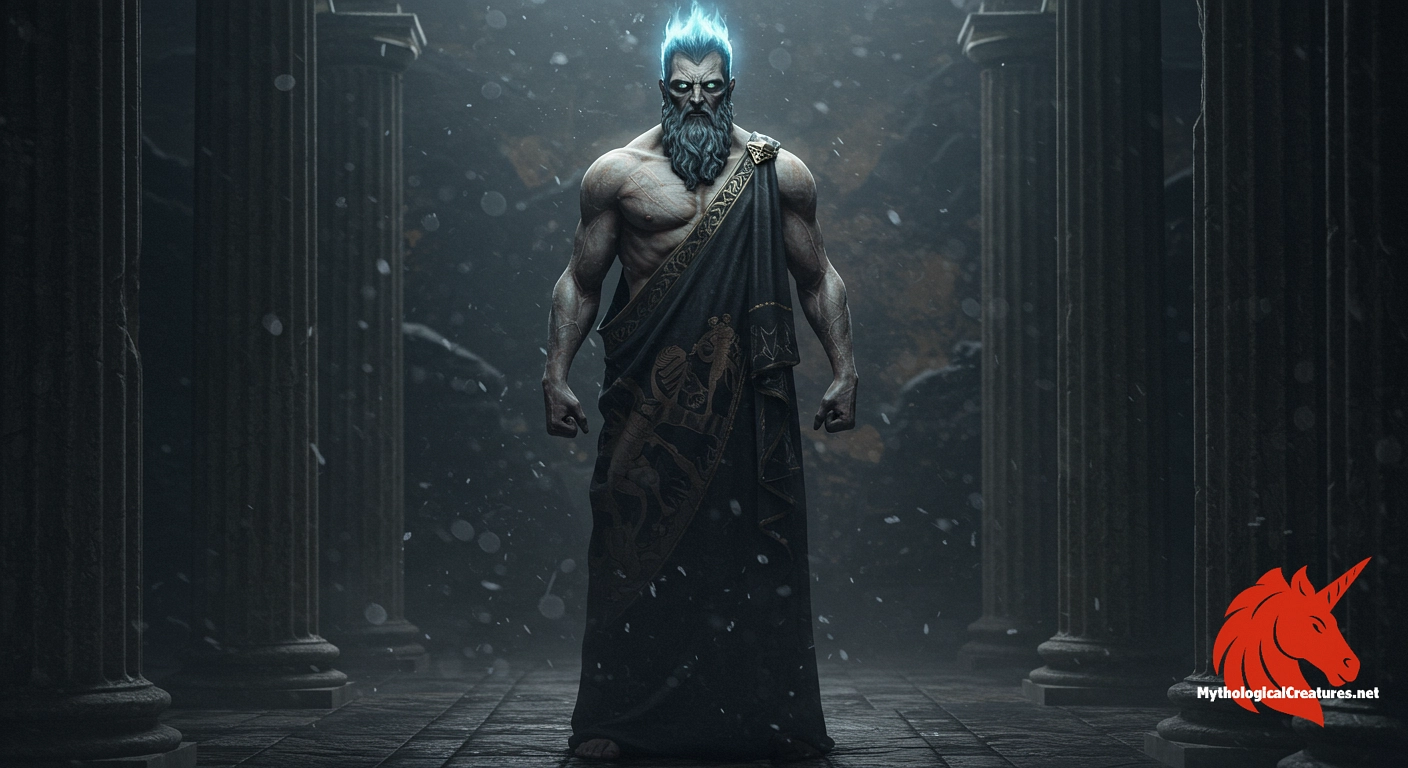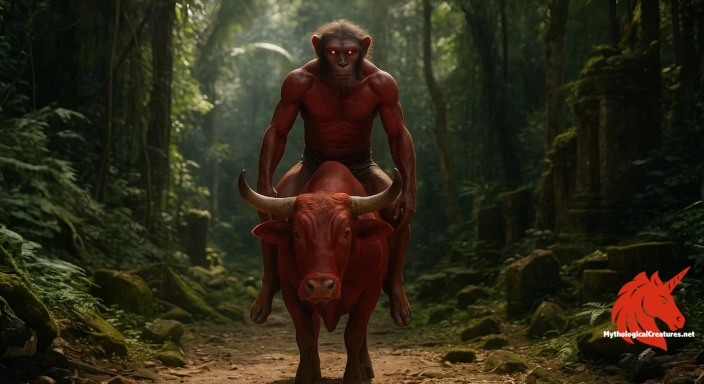Hades: Hades is the ancient Greek god of the dead and ruler of the underworld, often depicted with a bident and a helm of darkness.

Hades
Hades - A central figure in Greek mythology, Hades embodies the inevitability of death and the mysteries of the afterlife while also symbolizing the hidden wealth beneath the earth.
Origins & First Encounters
Hades stands as one of the most formidable and enigmatic figures in ancient Greek mythology, embodying the realm of the dead with an air of austere authority. Born to Cronus and Rhea, his origin is wrapped in both tumult and inevitability, emerging as the last son regurgitated by his father. His ascendancy, following the decisive defeat of the Titans alongside Zeus and Poseidon, established a new cosmic order in which each brother claimed a distinct realm. Hades was entrusted with the underworld—a domain that later became synonymous with his very name and with the mysteries of death. His mythical role is not rooted in malice, but as an essential custodian of fate, underscoring the natural balance between life and afterlife. Esteemed for his unyielding sense of duty, he maintained order within the obscure confines of his shadowed kingdom. Artistic depictions often highlight his iconic bident and helm, visual symbols that serve as emblems of his power and authority. His narrative encapsulates the ancient Greek contemplation of mortality, inspiring both fear and reverence. Over time, Hades has evolved into a multifaceted symbol, representing both the inevitable cessation of life and the hidden riches of the earth.
Source Texts & Tale Variants
Ancient literary sources provide rich insights into the character of Hades, with early accounts emerging in works such as Hesiod's Theogony and the Homeric Hymns. These texts reveal a deity who governs the underworld with a blend of inevitability and inscrutability. The myth of Persephone’s abduction, recounted in various accounts, offers one of the most detailed portrayals of his domain and decisions. In classical tragedies and epic narratives, Hades is depicted as a sovereign figure whose rulership is as formidable as it is inevitable. His portrayal in vase paintings and other visual media further supplements the textual narratives, providing a tangible sense of his presence. Later mythographers, particularly of the Roman era, reinterpreted Hades as Pluto, merging and expanding his attributes with local deities like Dis Pater and Orcus. The diversity of these early sources highlights the interplay between oral tradition and written myth, each adding layers of complexity to his character. Fragments of Orphic literature serve to deepen the mystique surrounding his role in the afterlife. A wealth of ancient sources, both literary and artistic, continues to shape modern interpretations of this complex deity.
Form & Powers
Hades is often visualised as a solemn, regal figure whose physical depiction mirrors the profound gravity of his domain. He is traditionally represented with a bident rather than the more common trident, a symbol that underscores his unique authority over the underworld. His visage is typically marked by a commanding demeanor, featuring a dark, meticulously groomed beard and eyes that seem to peer into the veil between life and death. Adorned in flowing, dark robes that accentuate his mysterious aura, his appearance radiates an inherent solemnity and power. The helm he dons, often portrayed as a tool for invisibility, further enhances his enigmatic presence. While his bodily form is as robust and majestic as that of any Olympian, it is his subtle expression—an amalgam of stern duty and introspective melancholy—that truly defines him. Artists have skilfully captured the paradox of Hades: a figure of both dread and dignified restraint. The accompanying image of Cerberus, his three-headed guardian, further cements the link between his physical iconography and the supernatural realm he governs. Through these elements, Hades personifies both the finality of death and the continuity of the afterlife.
Regional Faces
Variations in the portrayal of Hades can be discerned across different regions of the ancient Greek world, reflecting local customs and religious practices. In certain locales, particularly within parts of Asia Minor and the Peloponnese, his character is imbued with agricultural undertones, where he is revered as Plouton—‘the rich one’—highlighting his association with the fertile bounty of the earth. These regional adaptations often place greater emphasis on his role as a granter of subterranean wealth, merging the concepts of death and fertility. In some communities, local festivals and mystery rites centred around Hades celebrated both his stern rulership and his function as a benefactor of life’s cyclical renewal. Artistic representations and votive offerings varied, sometimes portraying him with softer features that intimated a more nurturing, albeit mysterious, aspect. Differences also emerge in the accompanying symbols; for instance, variations in the depiction of his helm or the portrayal of his attendant, Cerberus, reflect local iconographic traditions. Meanwhile, in Etruscan and early Roman realms, his persona was adapted into corresponding deities such as Aita and Dis Pater, illustrating a seamless syncretism with continental mythological traditions. These regional nuances not only underscore the adaptability of his myth but also reveal the diverse ways in which societies engaged with the themes of death and rebirth. Ultimately, the localised cult practices of Hades underscore a universal acknowledgement of death’s inevitable role, even as its cultural expression varies widely.
Cultural Parallels
Comparative mythology offers a fascinating window into the ways in which underworld deities, such as Hades, are represented across different cultures. His role as the ruler of the dead finds a close parallel in the Roman portrayal of Pluto, who, while sharing many similarities, is often cast in a more benevolent light associated with the prosperity of the earth. In Nordic traditions, the figure of Hel presents a distinct yet comparable vision of the afterlife, though her character is imbued with a more resigned and somber disposition. The Mesopotamian goddess Ereshkigal similarly rules over a grim, shadowy realm, drawing parallels in the representation of death and cosmic order. Hades is unique, however, in that his myth does not merely reflect a fear of death, but also celebrates the inevitability and necessity of mortal transition. These cross-cultural comparisons reveal a shared human preoccupation with life’s cyclical end, yet each culture overlays its own values and symbolism onto the figure of an underworld ruler. While his depiction among the Greeks is nuanced by a sense of dignity and solemn duty, similar figures elsewhere may lack such a refined balance. The examination of these diverse traditions underscores how cultural context shapes the understanding of death and beyond. In many ways, Hades’ myth resonates on a universal level, serving as an archetypal model for the necessary, if enigmatic, role of the afterlife in human existence. Such comparative insights enrich our modern interpretation of Hades, affirming his lasting influence across a spectrum of mythological traditions.
Legacy & Modern Evolution
The myth of Hades has undergone a significant transformation from the shadowy, visceral depictions of antiquity to a more complex and multifaceted modern portrayal. Traditionally characterised by his austere rulership of the underworld, Hades was once seen as a remote and implacable figure who embodied the inexorable laws of fate. Over time, however, his narrative has evolved to accommodate varied interpretations that explore the emotional and even ironic dimensions of his character. Modern literature, theatre, and film have reimagined Hades as a figure capable of both stern authority and unexpected empathy, often integrating contemporary concerns with mortality and destiny. The rebranding of Hades in popular culture, including graphic novels and video games, has contributed to a renewed fascination with the interplay of death, power, and redemption. His enduring image as the silent custodian of souls provides a rich tapestry for exploring themes of loss, transformation, and the inevitability of change. Recent creative works have sought to humanise him somewhat, portraying a deity burdened by duty but capable of introspection. This evolution mirrors wider cultural shifts in attitudes toward death and the afterlife, moving away from simplistic depictions toward more layered and reflective narratives. Today, Hades remains a potent symbol, inviting us to consider the complexities of mortality and the beauty of life’s cyclical nature.
Interesting Fact
Despite often being portrayed as a fearsome and grim figure, Hades was rarely considered evil in ancient Greek belief, functioning instead as a necessary and balanced force within the natural order of life and death.
Quick Creature Info
Origin:
Associations:
Our Mythic Legendary Rating:

Also Sometimes Known As:
Habitat:
Supernatural Powers:
Physical Attributes:
Abilities:
Behavior:
Lore:
References
Discover Another Mythical Legend You May Not Have Heard Of?
Uncover the mysteries of ancient folklore and expand your knowledge of legendary beings from cultures around the world.
Dare to Meet the Reeri Yakseya....
Mythical Disclaimer: The images and data on this site are derived from various historical and literary sources, but we have found that many myths often have multiple versions and interpretations across references, sometimes contradictory. As a result, these creature depictions are artistic interpretations—imaginative blends of folklore, legend, and a dash of AI guesswork. Because creature descriptions vary widely, our illustrations and accompanying information represent our best effort to honor mythology while bridging creative gaps. Enjoy these interpretations—just remember, we've done our best to respect the stories and validate available data, but in the realm of mythology, details often shift, imagination leads the way, and nothing is ever set in stone!
Curated by the Mythological Creatures Team (rev. May 2025)
